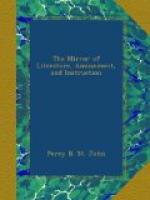BRUCE CASTLE, TOTTENHAM.
[Illustration: Bruce castle, Tottenham.]
The engraving represents this interesting structure, as it appeared in the year 1686; being copied from a print, after a picture by Wolridge.
The original castle was very ancient, as appears by the foundations, and an old brick tower over a deep well, the upper part of which has been used as a dairy. The castle is said to have been built by Earl Waltheof, who, in 1069 married Judith, niece to William the Conqueror, who gave him the earldom of Northampton and Huntingdon for her portion. Matilda or Maud, their only child, after the death of Simon St. Liz, her first husband, married David, first of the name, king of Scotland; and Maud, being heiress of Huntingdon, had in her own right, as an appendix to that honour, the manor of Tottenham in Middlesex.
Robert Bruce, grandson of David, Earl of Huntingdon, and grandfather to Robert I. of Scotland, memorable as the restorer of the independence of his country, became one of the competitors for the crown of Scotland in 1290, but being superseded by John Baliol, Bruce retired to England, and settled at his grandfather’s estate at Tottenham, repaired the castle, and acquiring another manor, called it and the castle after his own name. Shakspeare says,
Fearless minds climb soonest unto crowns,
and the fortunes of the two Bruces are “confirmation strong as holy writ.”
The estate being forfeited to the crown, it had different proprietors, till 1631, when it was in the possession of Hugh Hare, Lord Coleraine. Henry Hare, the last Lord Coleraine of that family, having been deserted by his wife, who obstinately refused, for twenty years, to return to him, formed a connexion with Miss Roze Duplessis, a French lady, by whom he had a daughter, born in Italy, whom he named Henrietta Roza Peregrina, and to whom he left all his estates. This lady married the late Mr. Alderman Townsend; but, being an alien, she could not take the estates; and the will being legally made, barred the heirs at law; so that the estate escheated to the crown. However, a grant of these estates, confirmed by act of parliament, was made to Mr. Townsend and his lady, whose son, Henry Hare Townsend, Esq. in 1792, voluntarily sold the property for the payment of the family debts; and “although the castle may soon be levelled with the ground, yet the destruction of this ancient fabric will acquire him more honour, than if the prudence of his ancestors had enabled him to restore the three towers, of which now only one remains."[1]
[1] Gough’s Camden.
The present mansion is partly ancient, and partly modern, and was very lately the property of Sir William Curtis, Bart. Up to the period at which the castle is represented in the engraving, the building must have undergone many alterations, as the tower on the left, and the two octagonal and centre towers, will prove. The grounds there appear laid out in the trim fashion of the seventeenth century, and ornamented with fountains, vases, &c.




